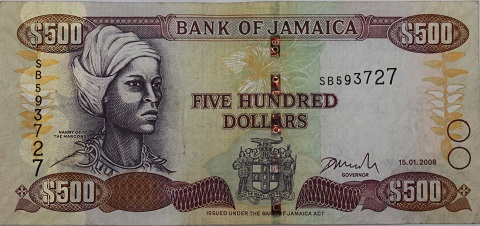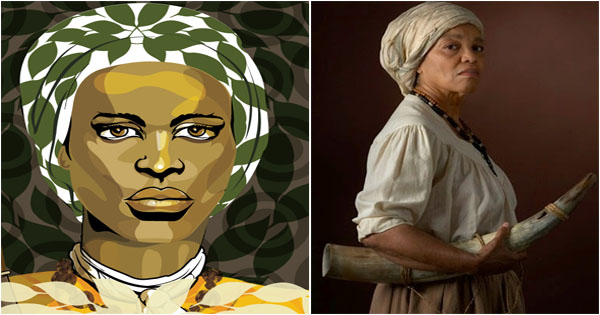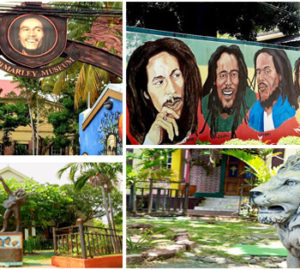Nanny (queen of the Maroons): heroine of the fight against slavery in Jamaica
Context
These slaves came from Gold Coast, Congo and Madagascar. Abused, enslaved, deprived of the right to defend themselves, African slaves worked in extremely harsh conditions. When the slaves escaped, they formed hidden communities living in the forests or the mountains.
Who is Nanny, queen of the Maroons? (around 1685 – 1733 or 1760)

Originally from the West African coast (Ghana), Nanny is a Jamaican heroine and leader, an emblematic figure of the resistance of the maroons against slavery. In the English language, the word “nanny” is used to designate a person who takes care of a child in the absence of his parents.
Born in 1685, of Akan ethnicity, she was kidnapped and enslaved in Jamaica with members of her people. As soon as they arrived, Nanny and his compatriots were sold to a plantation in the commune of Saint Thomas, near Port Royal. In these plantations, the working conditions were particularly harsh.
With his brothers Accompong, Cudjoe, Johnny and Quao, they fled the plantation and hid in the Blue Mountains region. From there, they led several revolts across Jamaica. For more than 30 years, she freed more than 800 slaves and helped them settle in the Brown communities. Nanny was married to a brown named Adou, but they had no children.
Who are the Maroons?
The Maroons are the descendants of the Afro-Caribbean. They are enslaved slaves who escaped from slavery and formed independent colonies of free women, men and children. In Jamaica, this group was called Coromantie or Koromantee. They formed their own community in the mountainous regions of the island. They came from the Akan region of West Africa and other parts of Africa.
They were seen as fierce, deadly and hard-fought fighters. They have refused their sad slave destinies and we prefer to resist and fight for their freedoms.
During Spanish governance, until 1650, the slaves escaped and married the native inhabitants of the island, the Arawaks.
Later, when the English took control of the colony, most of the slaves were able to flee the plantations to join the two main Maroon groups in Jamaica: the Windward and the Leeward, led respectively by chiefs Nanny and Captain Cudjoe .
For more than 150 years, the Maroons have helped free the slaves from the plantations by damaging the land and property belonging to the plantation owners.
Between 1655 and 1830, they led most of the slave rebellions in Jamaica. Spiritual and religious life was important. Almost all slave rebellions have involved African spiritual practices. Spiritual practices such as Obeah (and voodoo in Haiti) evolved from Africa, and during periods of slavery were of great importance to the black population.
Their resistance to slavery was based on their African cultures and identities. At each annual Maroon celebration of the Peace Treaties of 1739, there is a “private” element of the festivities which only the Maroons can attend, where ancestors are expected to visit the living, including Queen Nanny who is honored.
Battle for resistance.
After their escape, Nanny and her fighting brothers split up to organize more brown communities across Jamaica. Nanny and Quao founded the communities in the commune of Portland. Accompong went to the town of Saint Elisabeth in a town called Accompong Town. Cudjoe went to the town of Saint James and organized a village which was later named Cudjoe Town.
- Great military strategist and respected leader.
Queen Nanny was a well-respected spiritual, cultural, military leader who played a role in organizing plans to free the enslaved Africans. She guided the Maroons between 1725 and 1740 to fight against the British.
First, it positions its community in a strategic location to allow a single entry and exit from the city. This location was very effective, as it was located on a ridge, at a high altitude which overlooked the Stony River. That is to say 900 feet where there was a precipice, and along the precipice, there was a narrow path that led to the city. Thanks to this location, they were able to fight against English soldiers despite a smaller number of personnel. Being at high altitude made it possible to spot enemies, making any British ambush impossible.
In addition, Nanny had installed his guards at strategic points. They organized surveillance towers to deal with possible enemy attacks.
Also, she perfected the art of camouflage and created a long distance communication system using Abeng, it is a cow horn with a hole at one end. This highly sophisticated Maroon communication system has put British troops at a disadvantage. They were completely helpless in the Jamaican hills.
Finally, Nanny ordered his warriors to dress so as to look like trees and bushes. They thus covered themselves with branches and leaves. Then his men were sent to voluntarily show themselves to the British soldiers. These men served as bait, and when spotted, ran towards the Camouflaged Maroons. The British soldiers who had followed them were thus assaulted by the maroons who killed them.
The Maroons also used traps to trick the English in surprise attacks. This success comes from the fact that unguised Maroon appeared before the English and ran in the direction of disguised Maroon.
- Trade and liberation of slaves.
Nanny had organized a trade based on bartering food, weapons and clothes, which made it possible to support his community. The Maroons of Nanny Town also lived by cattle breeding, agriculture and hunting, because Nanny had verbatim imitated the way of life of the African villages of Ashanti.
A famous legend about Queen Nanny is that during 1737 at the height of Maroon’s resistance against the British, Nanny and his people were near famine and she was on the verge of surrender, when she heard voices from his ancestors telling him not to give up. When she woke up, she found pumpkin seeds in her pocket which she planted on the hill. Within a week, the seeds turned into large pumpkin-laden plants that provided food for the hungry community. To this day, one of the hills near Nanny Town is known as “Pumpkin Hill”.
The maroons raided the plantations to recover the property of the slave masters and to search for weapons and food, setting fire to the plantations and freeing the slaves to their communities. For more than 30 years, Nanny freed more than 800 slaves and helped them settle in the Brown communities.
Thanks to her intelligence and her mastery of the art of war, she defeated the British in many battles. Despite repeated attacks by British soldiers, the village of Nanny, nicknamed Nanny Town, remained under Brown control for several years.
- Obeah practitioner.
There were rumors that Nanny had magical powers resulting from the Obeah religion. Obeah is a popular magic originating in West Africa and at the same time a religion practiced in Suriname, Jamaica, Trinidad and Tobago, Guyana, Barbados, Belize and other Caribbean countries. It’s a mixture of mysticism and white and black magic.
For example, it was said in a legend that Queen Nanny was able to catch balls with her hands, which was an art form very developed in certain parts of Africa. She made fun of some British soldiers by asking them to use their guns on her. Surprised, the balls slipped on Nanny’s clothes, without killing her.
She also had extensive knowledge of healing herbs and other traditional therapeutic methods, practiced by the native inhabitants of the island and Africans. These attributes have enabled him to gain respect and care for the members of his community.
In another legend, Queen Nanny placed a large cauldron at the corner of a narrow mountain path near the edge. This pot was boiling even if there was no fire underneath. When the British soldiers strangely approached, they fell and died. It has been suggested that the jar contains special herbs with anesthetic properties. Contemporary historians maintain that the pot was in fact a circular basin formed by the dug rocks of the Nanny river, joined by the waters of the Stony river. The continuously flowing river kept the water constantly frothy, giving it the appearance of a boiling pot.
- Increasingly violent wars.
In the 1730s, the fighting was increasingly intense. British casualties numbered in the thousands, while the Maroons suffered only 100 casualties as a result of their war strategies.
After falling into several traps, the English resorted to their own ploys: Captain Stoddart who commanded a detachment employed against slaves. He established scree which destroyed their huts and several were killed there, others threw themselves into the precipices and some were taken.
Between 1728 and 1734, the attacks on the town of Nanny Town and other Maroons facilities intensified by the English forces, it was at this point, in 1733, that Nanny was killed. Nanny Town was finally captured by the British and destroyed in 1734.
In 1734, the town of Moore became the main town of the Maroons Windward – after the English destroyed the original town Maroon, which was known as ‘Nanny Town’..
Death of this warrior queen.
According to the Journal of the Assembly of Jamaica from March 29-30, 1733, Captain Sambo, a black slave who allegedly fought in the First War against the Maroons, known as William Cuffee, killed Nanny.
However, in 1739, a parcel of land was granted to Nanny and his descendants called the city Nanny Town.
Other stories tell that she lived as an old lady and died of natural causes around the year 1760. Thus, the exact date of her death remains a mystery and the confusion comes from the fact that Nanny was a term used as an honorary title attributed to people and to designate important personalities.
Another story goes that Queen Nanny came to Jamaica as a free woman, with slaves to them and that she was of royal blood.
Nanny’s remains were buried in the grave named “Bump Grave” in the town of Moore Town by the Maroons of Moore Town, one of the communities established by the Windward Maroon in the town of Portland.
Nanny was named national hero for Jamaica in 1976. She was immortalized in songs and legends. She will be remembered as the greatest emblematic figure of Jamaican resistance. The portrait of Nanny is found on the Jamaican $ 500 bill.

Do you know this heroine?












